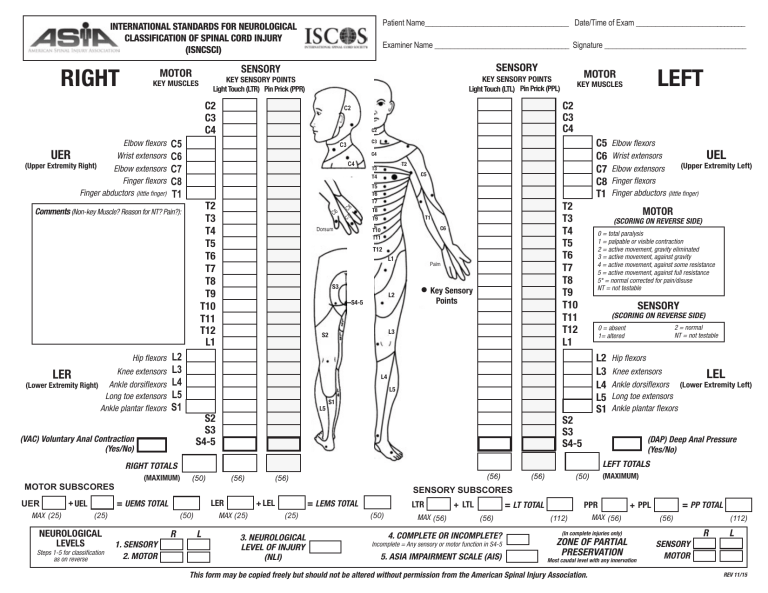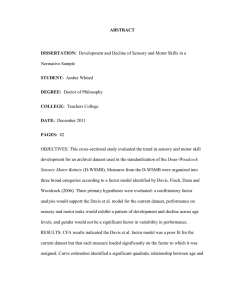
SENSORY C3 SENSORY C5 Elbow flexors C5 MOTOR MOTOR KEY SENSORYC4POINTS KEY SENSORY POINTS KEY MUSCLES KEY MUSCLES Wrist extensors Date/Time C6 C6 Patient Name_____________________________________ of UEL Exam _____________________________ Light Touch (LTR) Pin Prick (PPR) Light Touch (LTL) Pin Prick (PPL) INTERNATIONAL STANDARDS FOR NEUROLOGICAL T2 (Upper Extremity Left) T3 Elbow extensors C7 C7 C2 CLASSIFICATION OF SPINAL C5 T4 C2 CORD INJURY Examiner Name ___________________________________ C8 Finger flexorsC2Signature _____________________________________ C8 0 = absent (ISNCSCI) T5 C3 (little finger) C3 altered T6 T1 Finger abductors T1 21 == normal C4 C4 C2 T7 SENSORY NT = not testable SENSORY T2 T2 MOTOR C3 MOTOR T8 C3 cle? Reason for NT? Pain?): MOTOR C5 Elbow flexors KEY SENSORY POINTS KEY SENSORY POINTS C5 KEY MUSCLES T1 KEY MUSCLES T9 0 = absent T3 Elbow flexors T3 (SCORING ON REVERSE SIDE) Pin Prick (PPL) Light Touch (LTL) Light Touch (LTR) Pin Prick (PPR) C4 Wrist extensors 1 = altered UER Wrist extensors C6 UEL C6 C4 C6 T10 T4 2 = normal 0 = total paralysis T2 (Upper Extremity Right) T4 (Upper Extremity Left) T3 Elbow extensors T11 NT = not testable Elbow extensors C7 C7 C2 C2 C2 1 = palpable or visible contraction C5 T5 T5 T4 2 = active movement, gravity Finger flexors C8 0 = absentC3 T12 C8 Finger flexors C3 eliminated T5 T6 3 = active movement, against gravity T6 altered L1 bsent Finger abductors (little finger) T1 21 == normal C4 some resistance C2 T6 T1 Finger abductors (little finger) Palm C4 4 = active movement, against ltered T7 T7 T7 NT = not testable ormal 5 = active movement, against full resistance C3 T2 T2 Elbow flexors C5 C5 Elbow flexors C3 T8 not testable Comments (Non-key Muscle? Reason for NT? Pain?): MOTOR 5* = normal corrected for pain/disuse T8 T8 C4 T1 T9 0 = absent T3 T3 S3 Wrist extensors Wrist extensors NT = not testable UER (SCORING ON REVERSE SIDE) UEL C6 C6 = altered T9 Sensory T2 C4 • 21Key C6 L2 (Upper Extremity Left) (Upper Extremity Right) T9 Elbow extensors T10 T4 = normal T4 T3 0 = total paralysis Elbow extensors C7 C7 C2 S4-5 T11 NT Points = not testable T4 C5 T10 SENSORY T10 Finger flexors 1 = palpable or visible contraction T5 Finger flexorsgravity eliminated C8 0 = absentT5 2SIDE) = active movement, (SCORING ON REVERSEC8 T5 T12 T11 T11 1 = altered T6 3 = active movement, against(little gravity T6 T6 finger) (little finger) Finger abductors Finger abductors T1 T1 2 = normal L1 0 = absent 2 = normal 0 = absent Palm 4 = active movement, against some resistance T12 T7 T12 1 = altered L3 NT = not T7 testable T7 NT = not testable 1= altered 8 S2 8 T2 C3 C 6 C T2 2 = normal 5 = active movement, against full resistance T8 Comments (Non-key Muscle? Reason for NT? Pain?): MOTOR C C6 L1 L1= not testable NT 5* = normal corrected for pain/disuse T8 T1 C7 C7 T8 T9 T3 0 = absent T3 (SCORING ON REVERSE SIDE) NT = not testable 1 S3 =Dorsum altered C4 C6 Dorsum Hip flexors L2 T9 Hip flexors L2 T10 Key Sensory T9 • L2 T4 T4 2 = normal 0 = total paralysis T11 S4-5 NT = not testable Points 1 = palpable or SENSORY visible contraction Knee extensors L3 T10 T10 L3 Knee extensors T5 T5 LEL 2 = active movement, eliminated T12 L4 (SCORING ONgravity REVERSE SIDE) T11 (Lower Ankle dorsiflexors L4 T11 T6 Ankle dorsiflexors 3 = active movement, against gravity Extremity Left) T6 L4 L1 0 = absent L5 2 = normal Palm 0 = absent 4 = active movement, against some resistance 1 = altered T12 T12 ong toe extensors L5 L3 T7 T7 L5 Long toe extensors NT resistance = not testable S2 51==altered active movement, against full 2 = normal C8 6 C8 S1 6 C C NT = not testable L1 L5 nkle plantar flexors S1 flexors 5* = normal corrected for pain/disuse T8 S1 Ankle plantar L1 T8 C7 C7 S3 NT = not testable Key Sensory • Dorsum S2 Dorsum T9 Hip flexors L2 L2 Hip flexors S2 L2 T9 Points S4-5 T10 S3 Knee extensors L3 SENSORY S3 T10 L3 Knee extensors LER raction (DAP) Deep anal(SCORING pressureON REVERSE SIDE) LEL L4 T11 S4-5 L4 S4-5 T11 Ankle dorsiflexors (Lower Extremity Left) Yes/No) (Lower Extremity Right) Ankle dorsiflexors (Yes/No) L4 L5 2 = normal 0 = absent T12 Long toe extensors L5 L3 T12 Long toe extensors L5 S2 NT = not testable 1= altered S1 C8 6 C8 LEFT TOTALS L1 RIGHT TOTALS C C6 L1 Ankle plantar flexors S1 L5 S1 Ankle plantar flexors C7 C7 (MAXIMUM) (MAXIMUM) S2 S2 Dorsum Dorsum Hip flexors L2 L2 Hip flexors S SENSORY SUBSCORES S3 S3 L3 Knee extensors L3 Knee extensors (VAC) Voluntary (DAP) Deep anal pressure LEL LER anal contraction L4 LER + LEL L4 = LEMS TOTAL = UEMS TOTAL S4-5 LTR + LTL S4-5 PPR + PPL = LT TOTAL = PP TOTAL (Yes/No) (Lower Extremity Left) Ankle dorsiflexors (Lower Extremity Right) Ankle dorsiflexors L4 (Yes/No) L5 (25) (50) (50) MAX (25) MAX (56) MAX (56) (56) (56) (112) Long toe (112) extensors Long toe extensors L5 L5LEFT TOTALS S1 RIGHT TOTALS L5 Ankle plantar flexors flexors S1 (In complete injuries only) S1 R L R L Ankle plantar (MAXIMUM) 4. COMPLETE OR INCOMPLETE? (MAXIMUM) 3. NEUROLOGICAL ZONE OF PARTIAL S2 Incomplete = Any sensory or motor function in S4-5 S2 SENSORY 1. SENSORY MOTOR SUBSCORES LEVEL OF INJURY SENSORY SUBSCORES PRESERVATION S3 S3MOTOR 2. MOTOR 5. ASIA IMPAIRMENT SCALE (AIS) (NLI) Most caudal level with any innervation LER + LEL (VAC) Anal Contraction UER Voluntary + UEL (DAP) Deep= Anal Pressure = LEMS TOTAL = UEMS TOTAL LTR + LTL + PPL = LT TOTAL PP TOTAL S4-5 S4-5 PPR (Yes/No) Elbow flexors Wrist extensors Elbow extensors Finger flexors bductors (little finger) RIGHT LEFT RIGHT LEFT MAX (25) (25) permission from the (50) (25) (50)but should MAX This form may be copied freely not(25) be altered without American Spinal MAXInjury (56) Association. (56) NEUROLOGICAL LEVELS RIGHT TOTALS R (MAXIMUM) 1. SENSORY MOTOR Steps 1-5SUBSCORES for classification 2. MOTOR as on reverse UER + UEL = UEMS TOTAL MAX (25) (25) NEUROLOGICAL LEVELS Steps 1-5 for classification as on reverse L LER R 4. COMPLETE OR INCOMPLETE? Incomplete = Any sensory or motor function in S4-5 5. ASIA SENSORY IMPAIRMENTSUBSCORES SCALE (AIS) LTR + LTL = LT TOTAL MAX (25) L (25) 3. NEUROLOGICAL LEVEL OF INJURY (NLI) (50) MAX (56) (56) 4. COMPLETE OR INCOMPLETE? Incomplete = Any sensory or motor function in S4-5 5. ASIA IMPAIRMENT SCALE (AIS) (112) LEFT TOTALS (In complete injuries only) (MAXIMUM) ZONE OF PARTIAL PRESERVATION Most caudal level with any innervation This form may be copied freely but should not be altered without permission from the American Spinal Injury Association. (50) 1. SENSORY 2. MOTOR 3. NEUROLOGICAL LEVEL OF INJURY (NLI) + LEL = LEMS TOTAL REV (Yes/No) 02/13(56) MAX (56) (112) PPR (112) R + PPL MAX (56) (56) = PP TOTAL REV 02/13 (In complete injuries only) ZONE OF PARTIAL PRESERVATION Most caudal level with any innervation This form may be copied freely but should not be altered without permission from the American Spinal Injury Association. L SENSORY MOTOR SENSORY MOTOR (112) R L REV 11/15 Muscle Function Grading 0 = total paralysis 1 = palpable or visible contraction 2 = active movement, full range of motion (ROM) with gravity eliminated 3 = a ctive movement, full ROM against gravity 4 = active movement, full ROM against gravity and moderate resistance in a muscle specific position 5 = (normal) active movement, full ROM against gravity and full resistance in a functional muscle position expected from an otherwise unimpaired person 5* = (normal) active movement, full ROM against gravity and sufficient resistance to be considered normal if identified inhibiting factors (i.e. pain, disuse) were not present NT = not testable (i.e. due to immobilization, severe pain such that the patient cannot be graded, amputation of limb, or contracture of > 50% of the normal ROM) Sensory Grading 0 = Absent 1 = Altered, either decreased/impaired sensation or hypersensitivity 2 = Normal NT = Not testable When to Test Non-Key Muscles: In a patient with an apparent AIS B classification, non-key muscle functions more than 3 levels below the motor level on each side should be tested to most accurately classify the injury (differentiate between AIS B and C). Movement Root level Shoulder: Flexion, extension, abduction, adduction, internal and external rotation Elbow: Supination C5 C6 Finger: Flexion at proximal joint, extension. Thumb: Flexion, extension and abduction in plane of thumb C7 Finger: Flexion at MCP joint Thumb: Opposition, adduction and abduction perpendicular to palm C8 Finger: Abduction of the index finger T1 Hip: Adduction L2 Hip: External rotation L3 Hip: Extension, abduction, internal rotation Knee: Flexion Ankle: Inversion and eversion Toe: MP and IP extension the sacral segments S4-5. B = Sensory Incomplete. Sensory but not motor function is preserved below the neurological level and includes the sacral segments S4-5 (light touch or pin prick at S4-5 or deep anal pressure) AND no motor function is preserved more than three levels below the motor level on either side of the body. C = Motor Incomplete. Motor function is preserved at the most caudal sacral segments for voluntary anal contraction (VAC) OR the patient meets the criteria for sensory incomplete status (sensory function preserved at the most caudal sacral segments (S4-S5) by LT, PP or DAP), and has some sparing of motor function more than three levels below the ipsilateral motor level on either side of the body. (This includes key or non-key muscle functions to determine motor incomplete status.) For AIS C – less than half of key muscle functions below the single NLI have a muscle grade ≥ 3. D = Motor Incomplete. Motor incomplete status as defined above, with at least half (half or more) of key muscle functions below the single NLI having a muscle grade ≥ 3. the ISNCSCI are graded as normal in all segments, and the patient had prior deficits, then the AIS grade is E. Someone without an initial SCI does not receive an AIS grade. Using ND: To document the sensory, motor and NLI levels, the ASIA Impairment Scale grade, and/or the zone of partial preservation (ZPP) when they are unable to be determined based on the examination results. L5 Hallux: Adduction S1 The following order is recommended for determining the classification of individuals with SCI. 1. Determine sensory levels for right and left sides. The sensory level is the most caudal, intact dermatome for both pin prick and light touch sensation. 2. Determine motor levels for right and left sides. Defined by the lowest key muscle function that has a grade of at least 3 (on supine testing), providing the key muscle functions represented by segments above that level are judged to be intact (graded as a 5). Note: in regions where there is no myotome to test, the motor level is presumed to be the same as the sensory level, if testable motor function above that level is also normal. 3. Determine the neurological level of injury (NLI) This refers to the most caudal segment of the cord with intact sensation and antigravity (3 or more) muscle function strength, provided that there is normal (intact) sensory and motor function rostrally respectively. The NLI is the most cephalad of the sensory and motor levels determined in steps 1 and 2. 4. Determine whether the injury is Complete or Incomplete. (i.e. absence or presence of sacral sparing) If voluntary anal contraction = No AND all S4-5 sensory scores = 0 AND deep anal pressure = No, then injury is Complete. Otherwise, injury is Incomplete. 5. Determine ASIA Impairment Scale (AIS) Grade: Is injury Complete? If YES, AIS=A and can record ZPP (lowest dermatome or myotome NO on each side with some preservation) Is injury Motor Complete? If YES, AIS=B NO (No=voluntary anal contraction OR motor function more than three levels below the motor level on a given side, if the patient has sensory incomplete classification) Are at least half (half or more) of the key muscles below the neurological level of injury graded 3 or better? NO L4 Hallux and Toe: DIP and PIP flexion and abduction A = Complete. No sensory or motor function is preserved in E = Normal. If sensation and motor function as tested with Elbow: Pronation Wrist: Flexion Steps in Classification ASIA Impairment Scale (AIS) INTERNATIONAL STANDARDS FOR NEUROLOGICAL CLASSIFICATION OF SPINAL CORD INJURY AIS=C YES AIS=D If sensation and motor function is normal in all segments, AIS=E Note: AIS E is used in follow-up testing when an individual with a documented SCI has recovered normal function. If at initial testing no deficits are found, the individual is neurologically intact; the ASIA Impairment Scale does not apply.



